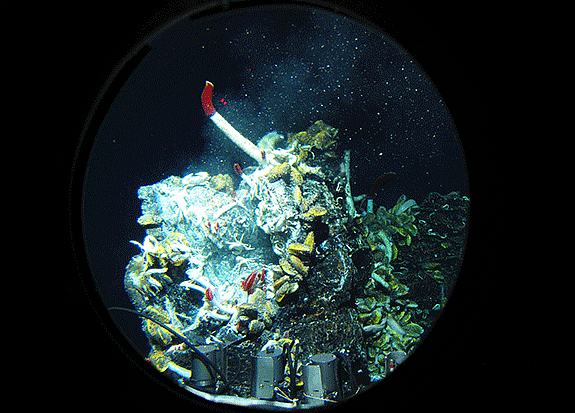Earth’s Last Frontier

It should come as no surprise that our planet was nicknamed “the pale blue dot” in the wake of the 1990s iconic photograph taken by Voyager. Approximately 68 percent of Earth’s surface is covered with water—that is, two-thirds of our galactic home is oceans and seas. With an average depth of 3,800 meters (roughly 2.3 miles), most of Earth’s oceans are well within the realm of the deep sea and represent, considering water column and sediments, 95 percent of the global biosphere. The deep sea is the largest and least explored habitat on Earth, and our knowledge of the biodiversity and functioning of the deep-sea ecosystem is incomplete at best.
By definition, the deep sea starts where less than 1 percent of light penetrates—on average, this happens at around 200 meters depth. From there to the seafloor, the deep sea is a cold, dark place. It is not only the largest ecosystem on our planet, but also our largest extreme environment. Average temperatures range from 0 to 4°C, and pressures can reach a crushing 1,100 bar in the Challenger Deep (Mariana Trench; 10,994 meters depth). For centuries—from Socrates to the late nineteenth century—humans believed the deep sea was a sterile, dead desert. Great minds of the time considered its extreme conditions prohibitive for life.
The Challenger Expedition (1872–76), the first modern oceanographic cruise, set out to challenge this mindset. For the first time in human history, this groundbreaking around-the-globe expedition, financed by the Royal Society of London, probed the unknown depths of the oceans, reporting life beyond the first few tens of meters of seawater. Those aboard the expedition reported 4,700 new species, created charts of circulation, depth, and temperature of the world’s oceans, and discovered the dizzying fact that most of our planet’s surface lies deep beneath the ocean waves. Despite this new appreciation, prevailing hypotheses throughout much of the twentieth century construed life in the deep sea as inconsistent, ephemeral, and limited to the first 1,000 or so meters of depth. In 1977, a second key discovery forever changed how we perceive life on Earth and beyond. An oceanographic expedition led by Richard Von Herzen and Robert Ballard (from Woods Hole Oceanographic Institution) discovered an oasis of exotic and unknown life basking around hot fluids venting from a crack in the seafloor basalt at 2,500 meters depth along the Galapagos Rift.
We now know that life is present at all depths in the oceans (and even deeper into our planetary crust, but this is another story). We also know that deep-sea hydrothermal vents are a common feature along ocean ridges, and together with other types of extreme environments (such as cold seeps and deep hypersaline anoxic basins), sustain gardens of life, both microscopic and macroscopic, worldwide. At deep-sea vents, cold oxygenated seawater percolates deep through seafloor cracks where it is heated by geothermal activity and enriched in reduced-metal species and gases before returning back to the seafloor. Contact between these hot fluids (with temperatures anywhere from 25 to 450°C) and the ~2°C surrounding seawater precipitates sulfide metals, creating massive columnar structures—tens of meters in height—known as hydro thermal chimneys. Life around these chimneys is made possible by the activity of thermophilic (i.e., heat-loving) microorganisms that effectively make a living from reduced volcanic gases and carbon dioxide (chemo-synthesis) much like plants do on the surface of our planet (photosynthesis), but without the need for light to power their molecular machinery.
The realization that life exists in hot, dark, anoxic places as sustainable, large, and productive ecosystems independent of photosynthetic primary producers profoundly changed our understanding of how and where life could exist in the universe. Research on deep-sea hydrothermal vent microorganisms ignited a new wave of theories on the origins of life on Earth, as well as how scientists look for life elsewhere. Active hydrothermal vents were recently reported on Saturn’s moon Enceladus, are likely beneath the frozen surface of Jupiter’s moon Europa, and may have existed on ancient Mars.
Despite interest in the microbiology of deep-sea hydrothermal vents and the deep sea in general, research and exploration of Earth’s last frontier is still scarce. There was a moment in the ’60s and ’70s when science and popular literature alike depicted the colonization of the oceans by humans, but that moment has come and gone, leaving behind shrinking research budgets and growing commercial interests. Currently, only six research submarines are capable of diving below 4,000 meters. Meanwhile, financial interests in exploiting deep-sea resources are growing. Industrial deep-sea fishing is a booming industry, with unclear impacts on deep-sea ecosystems. Deep-sea mining is also growing quickly, with the number of granted mining licenses increasing every year. The ocean floor is a rich source of metals and rare-earth elements, and the International Seabed Authority has already granted permits to mine very large portions of the seafloor, often with very little public awareness. Currently, there is no way to predict the direction and magnitude of potential ecosystem impacts of such large-scale deep-sea mining efforts.
Microbes dominate deep-sea and extreme environments, often constituting the only living biomass in these ecosystems. Despite this, we have a limited understanding of the total biodiversity—both microscopic and macroscopic—in the deep ocean. Our comprehension of its role in sustaining ecosystem functioning and providing goods and services to the entire planet is even smaller. What is the extent and activity of microbial populations in the deep sea and seafloor subsurface? How are microbial populations structured and how are they connected? Is there functional redundancy within a population and is it critical in maintaining ecosystem functions during and after perturbation? How have human activities impacted this ecosystem, and how will these changes impact human populations in turn? How did life adapt to such extreme conditions? Or, more accurately, how did life adapt to surface conditions, assuming it originated at the ocean floor in ancient analogues of modern deep-sea hydrothermal vents? These and other basic questions will require our undivided attention as a scientific community. The deep sea is the largest habitat on Earth, and it plays a key role in many crucial features of this planet, including climate and the carbon cycle. Understanding how deep-sea ecosystems function is vital to maintaining equilibrium on this planet and to shedding light on how our pale blue dot became—thus far—the only planet harboring life.
